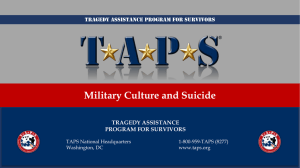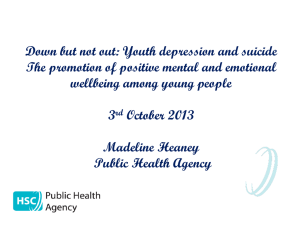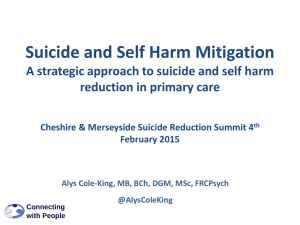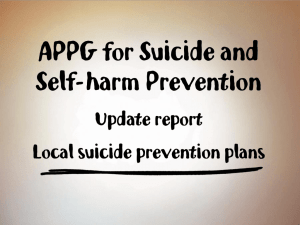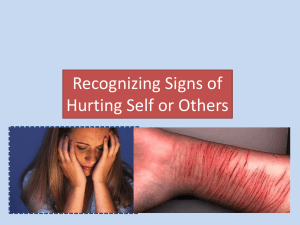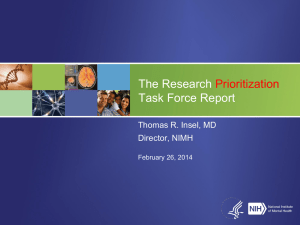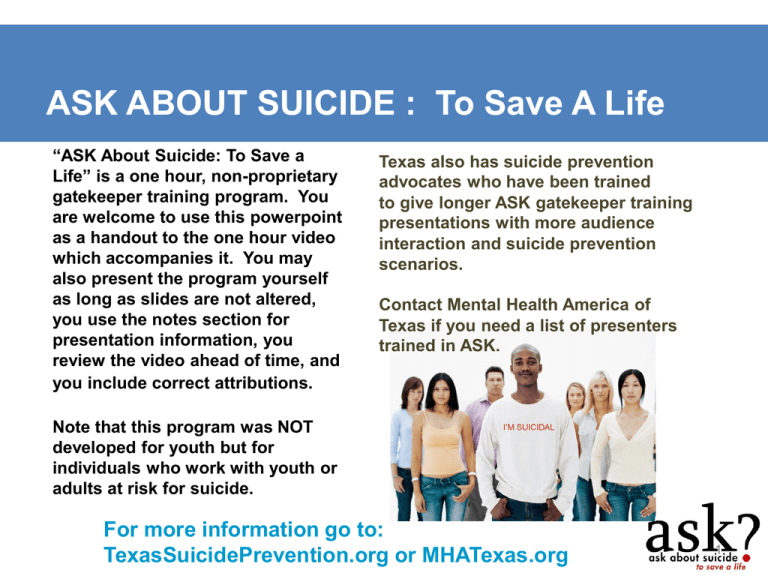
ASK ABOUT SUICIDE : To Save A Life
“ASK About Suicide: To Save a
Life” is a one hour, non-proprietary
gatekeeper training program. You
are welcome to use this powerpoint
as a handout to the one hour video
which accompanies it. You may
also present the program yourself
as long as slides are not altered,
you use the notes section for
presentation information, you
review the video ahead of time, and
you include correct attributions.
Texas also has suicide prevention
advocates who have been trained
to give longer ASK gatekeeper training
presentations with more audience
interaction and suicide prevention
scenarios.
Contact Mental Health America of
Texas if you need a list of presenters
trained in ASK.
Note that this program was NOT
developed for youth but for
individuals who work with youth or
adults at risk for suicide.
For more information go to:
TexasSuicidePrevention.org or MHATexas.org
1
ASK ABOUT SUICIDE : To Save A Life
Developed by:
Merily H. Keller,
hodgekeller@yahoo.com
With contributions from
Lloyd Potter, PhD, M.P.H., University
of Texas at San Antonio
John Hellsten, PhD, Texas DSHS
Injury Epidemiology and EMS Trauma
Registry Group and
Jennifer Battle, MSW, MHMRA of
Harris County HelpLine Director
Review & assistance from Texas
Suicide Prevention Council
TODAY’s Presenter/s:
Merily H. Keller
Jenna Heise
Jenna.Heise@dshs.state.tx.us
Funding for this training was made possible (in part)
by grant number SM059174 from SAMHSA. The
views expressed in written training materials or
publication and by speakers and trainers do not
necessarily reflect the views, opinions, or policies of
CMHS, SAMHSA, or HHS; nor does mention of trade
names, commercial practices, or organizations imply
endorsement by the U.S. Government.
For more information go to:
TexasSuicidePrevention.org or MHATexas.org
2
Texas Youth Suicide Prevention Grant
Best Practice Public Education, Outreach & Training
Texas has a State Plan for • MHAT & The Texas Suicide
Suicide Prevention
Prevention Council provide
• TexasSuicidePrevention.org
education for policy issues
and have website with state
Texas Youth Suicide
laws relating to suicide (see
Prevention Grant
handout.)
• Project partners: Mental
Health America of Texas,
• Example HB 1386 – current
Center for Healthcare
workgroup (DSHS, ESCs,
Services, Texas Department
MHAT & TEA) are using the
of State Health Services.
Suicide Prevention
The Texas Suicide Prevention
Resource Center's Best
Council has 29 local
Practices Registry's list of
coalitions & 21 statewide
recommended programs.
partners supported by
MHAT.
3
Statewide Best Practices
Training:
•At Risk online interactive training for high school and
college educators and college students
• Best Practices Registry Status
•ASK Gatekeeper Training
• Being submitted for Best Practices Registry
•10,000 people in Texas have received Gatekeeper
Training since YSPG started in 2005
•Training developed and adapted for special
audiences that work with youth, including:
• Educators
• Medical and Mental Health Professionals
• Others
4
ASK is a Gatekeeper
Training Program
ASK about suicide
to save a life
is a suicide prevention
Gatekeeper Training
Program to help people
learn how to--
• ASK about
suicide
• SEEK more
information
(& Keep SAFE)
• KNOW where and
how to refer
ASK is a process to offer HOPE to
help prevent a tragic loss of life
and NOT a form of counseling or
treatment.
5
What do we know about suicide in
TEXAS…
Number of deaths in Texas:
2,618 suicide deaths in 2008 and 2,795 in 2009
1½ times more suicides than homicides
Average of 7.5 deaths each day by suicide
2nd leading cause of death among young adults (25-34
years)
3rd leading cause of death of teens and college aged
youth (15-24 years)
Although there is no one cause, 90% of those who die
by suicide have an underlying mental health or
substance abuse condition. It affects nearly 20% of
those with bipolar disorder and 15% of those with
schizophrenia.
Source: Centers for Disease Control and Prevention, WISQARS
6
What do we know about suicide ?
Gender: across all ages; more males die by suicide
and more females attempt suicide.
Ethnicity/Culture: For youth, the highest selfreported attempts in the U.S. is among Latina female
teens and the highest death rate for both teens and
adults is for White males. Note: recent years have
seen some death rate increases for young African
American males.
Note: African American females have tended to have
some of the lowest suicide death rates through the
years….Why? Protective factors?
(Data from suicidology.org, WISQARS, and Texas DSHS searchable
database http://soupfin.tdh.state.tx.us/cgi-bin/death)
7
What do we know about suicide ?
(When time, add slides from best practice based websites with new research geared to the
audience’s specific needs and roles. Websites are listed at end of powerpoint.)
New Research & Information of Interest
8
What Do We Know
About Suicide Attempts
in Texas…
Almost 1 in 3 students felt
depressed in the past 12
months.
More than 1 in 6 students
considered suicide.
More than 1 in 7 made a
plan to commit suicide.
Texas 2011 Youth
Risk Behavioral
Survey
More than 1 in 10 students
actually attempt suicide.
1in 50 make attempts so
severe that they require
medical attention.
33 students in our sample
had attempted suicide 6 or
more times in the past 12
months.
What we DO know about suicide…
From a Public Health perspective, it is considered to
be one of the most preventable of deaths …. IF
We Recognize and Lower Risk Factors
Support Protective Factors
Recognize Warning Signs and
Are Trained and Ready to:
Ask About Suicide
Seek More Information (& Keep Safe)
Know Where & How to Refer
11
Risk Factors
Risk Factors are
stressful events,
situations, or
conditions in a person’s
life that may increase
the likelihood of
attempting or dying by
suicide.
12
Risk Factors: Bio-Psycho-Social
Biological & Psychological:
•
•
•
•
•
•
•
•
•
Mental Illness
Substance Abuse
Hopelessness
Impulsiveness or
Aggressiveness
Trauma/Abuse/Bullying
Major Physical Illness
Family History of Suicide
Pre-existing Vulnerability
(obese, GLBTQ, awkward,
G&T …)
Previous Suicide Attempt
13
Risk Factors: Mental and Addictive
Disorders
Note: Biological & Psychological Factors, include-• Mental and addictive disorders, often co-occurring,
as the most powerful risk factors for suicide in all
age groups.
• Mental or addictive disorders are thought to be
present in at least 90 percent of all completed
suicides.
• Bipolar and schizophrenia are two disorders that
have been found to have particularly strong
associations with suicidal behavior.
Source: Moscicki, Eve K. Identification of suicide risk factors using epidemiologic studies. Psychiatric
Clinics of North America. Vol 20(3), Sep 1997, 499-517
14
Risk Factors: Social-Cultural
Social – Cultural
• Isolation and lack of
social support
(Bullying, GLBT, G&T,
Obese, others)
• Stigma to seeking help
(men, rural, military,
law enforcement,
others)
• Barriers to health and
mental health care
• Cultural and/or
religious beliefs that
normalize suicide
15
Risk Factors: Environmental
• Loss (Job or
Financial)
• Loss (Relationship)
• Easy access to
lethal means
• Exposure to
clusters of suicide
16
Protective Factors
(can act as “safety lines”)
• “Protective factors
are the positive
conditions, personal
and social
resources that
promote resiliency
and reduce the
potential for suicide
as well as other
high-risk
behaviors.”
17
Protective Factors
• Effective clinical care for
mental, physical and
substance use
• Access to clinical
interventions and support for
help seeking
• Restricted access to highly
lethal means of suicide
• Connections to family and
community support
• Ongoing medical and mental
health care relationships
• Skills in problem solving,
conflict resolution and
nonviolent handling of disputes
• Cultural and religious beliefs
that discourage suicide and
support self preservation
18
Entering
Suicidal Zone
When risk factors are high and
protective factors are low, proximal
risk factors (or stressors) can
interact with a person’s long term
or underlying risks so that a person
gets into a “suicidal zone” (but this
is for short time period.)
19
Direct Suicidal Communication or
Behavior = Acute or High Degree of Risk
The best practice registry consensus
statement lists two “levels” of warning signs
Acute Risk includes:
• Threatening to hurt or kill him/herself, or
talking of wanting to hurt or kill him/herself;
and/or,
• Looking for ways to kill him/herself by
seeking access to firearms, available pills,
or other means; and/or,
• Talking or writing about death, dying or
suicide
Source: Suicide Prevention Resource Center, (sprc.org), Best Practice Registry Section II
From: Suicide
Prevention Resource
Center, Best
Practices Registry
Section II.
20
Other Warning Signs =
Chronic or Moderate Risk
Feelings (5 Main Ones)
• No reason for living/no
sense of purpose in life
• Feeling trapped, like
there’s no way out
• Hopelessness
• Dramatic mood
changes (high or low)
• Anxiety/agitation
•
From: Suicide Prevention Resource
Center, (sprc.org), Best Practice Registry
Section II
Behavior (5 Main Ones)
• Increased substance
abuse
• Withdrawal from
friends/family/society
• Rage/anger/revenge
• Reckless or risky
activities
• Unable to sleep or
sleeping all the time
21
Direct Suicidal Communication
or Behavior:
Acute Risk - Take Immediate Action
HIGH RISK=
TAKE ACTION NOW!
1– Take Immediate
Action
2 – Keep Safe / Do Not
Leave Alone
3 – Call 911 or seek
immediate help from a
mental health provider at
school or in community.
(or call your mobile
crisis outreach team, or
take to nearest hospital
emergency room)
22
Other Warning Signs =
Moderate or Chronic Degree Risk
MODERATE/CHRONIC
RISK =
1– Take All Signs
Seriously.
2 – Refer to a Mental
Health Professional or
Call
1-800-273-TALK (8255)
for a referral.
23
Look for Constellations of Signs
•Trust your instincts – if the thought
of suicide crosses your mind,
assume it has crossed the mind of
the person you are talking to.
•The higher the underlying risk
factors, the lower the protective
factors and the more warning signs
shown or communicated, the higher
the overall risk of suicide.
24
Warning Signs Can be Communicated
Verbally or Nonverbally
:
Direct and Indirect Verbal Signs
•“I want to kill myself.” (Suicidal communication)
•“I’ve been thinking about suicide.” (Suicidal
communication)
•“I just want out. I can’t take it anymore.”
(Feeling trapped)
•“I feel hopeless…it’s not worth living.”
(Hopelessness)
•“People would be better off without me.”
(Perceived burdensomeness)
•“Sometimes I just want to go to sleep and not
wake up.” (Thoughts of death)
25
Warning Signs: Behavior
:
•“Just leave me alone – I don’t
want to leave my room.”
(Isolation)
• “I just want to stay stoned…..
maybe forever.”(Substance abuse)
•“I can’t sleep and have been
really wired for past few weeks!”
(decreased sleep) or “All I want
to do is sleep all the time.”
(Increased sleep)
• “Do you know where I can get a
gun?” OR “Where does Mom keep
her anti-anxiety pills?” (Seeking
access to lethal means)
•“I just wish I could get back at
the people who did this to me!”
(Rage & seeking revenge)
•“Please take my CD collection, I’m
not going to need it anymore.”
(Making plans by giving away prized
possessions)
26
What you can do when you hear suicidal
language or suspect someone is suicidal
Take the following 3 steps:
1. ASK About Suicide
2. Seek More Information/ Keep Safe
3. Know Where and How to Refer
(Take Action!)
27
Asking is the first step in Saving a Life!
REMEMBER
Asking about suicide does not put the
thought of killing oneself in someone’s head,
but gives them a sense of relief that
someone is finally hearing them and will
LISTEN.
28
Step 1: How to Ask About Suicide
Indirect
• Sometimes when
people are as sad as
you are, they think
about suicide. Have
you ever thought
about it?
• Do you ever want to
go to bed and never
wake up?
Direct
• Have you thought
about suicide?
• Do you want to kill
yourself?
• Are you thinking
about suicide?
29
Step 1: How to Ask About Suicide
Don’t say
Be Aware
• You’re NOT thinking of • Of your non-verbal
cues.
suicide, are you?
• How you ask is not
•You wouldn’t do
as important as the
something really stupid,
ASKING itself. If
would you?
you can’t do it, find
someone who can.
30
Step 2: SEEK more information &
Keep SAFE
1.Seek a private area to talk.
2.Seek to establish a relationship.
3.Comment on what you see and observe nonjudgmentally.
4. Be curious about their perceived problem.
Find out how long they’ve thought about
suicide and if they’ve attempted suicide in the
past and if tried to get help.
31
STEP 2: SEEK more information &
Keep SAFE
5. Seek to find out if they are at immediate high risk of suicide:
(do they have a plan?) (have they rehearsed it in their mind?)
and/or (do they have a gun, access to pills or other means?)
Take immediate steps to limit access to means and assure
safety if YES.
6. Find out who and where they normally go to for help (family,
friends, pastor, neighbor, roommate, girl/boy friend).
7. Find out if they have a regular doctor, mental health
provider or counselor.
8. Be sure to be aware of your own non-verbal reactions and
tone of voice!
32
STEP 2: SEEK more information &
Keep SAFE
As you seek more information, help ensure the
person’s safety and/or help them start to
implement a safety plan.
With immediate risk of suicide,
Call 911 or get someone to the nearest
hospital emergency room!
33
STEP 3: KNOW –
How and Where to Refer?
The third step in the referral process is to
KNOW where to refer nationally, in Texas
and in your area, your school or your
community.
National Suicide Prevention Lifeline:
1-800-273-TALK\1-800-273- 8255
SAVE A NUMBER TO SAVE A LIFE
34
STEP 3: KNOW - Where to Refer in
Texas and in Your Local Area
911s, Hospitals, Law Enforcement and Mobile Crisis
Outreach Teams
• In an immediate risk, call 911, your local police, campus
police, or the sheriff’s office or take the person to the
nearest hospital emergency room. (Keep a list of nearest
hospital emergency rooms on your referral card/sheet.)
• Note: Many Texas law enforcement agencies have officers
trained in mental health. You can ask for a mental health
officer.
• Note: Many Texas communities have mobile crisis
outreach teams. Find out if there is one in your area and
obtain their contact number.
35
STEP 3: KNOW - Where to Refer in
Texas and in Your Local Area
Texas Crisis Line Options
All MHMRs/LMHA in the State of Texas are required to
provide a 24-hour crisis line for their service area (which
may be a county or a region of counties) and these lines are
required to be certified by the American Association of
Suicidology.
To find the number to the MHMR crisis line closest to you, log
onto the DSHS website, www.dshs.state.tx.us, under Reference
Center or go to www.TexasSuicidePrevention.org and look for
crisis centers in the appendix for your county or download the
free Mobile ASK website on your smart phone at
www.mhatexas.org/ask/.
(Discuss local referral lists and/or action plans)
36
YOU CAN SAVE A LIFE :
Resources for more information
American Association of Suicidology
http://www.suicidology.org/web/guest
American Foundation for Suicide Prevention
http://www.afsp.org/
Centers for Disease Control
http://www.cdc.gov/ViolencePrevention/suicide/index.html
National Action Alliance for Suicide Prevention
http://actionallianceforsuicideprevention.org/
National Suicide Prevention Lifeline
http://www.suicidepreventionlifeline.org/
Substance Abuse and Mental Health Services Administration
http://www.samhsa.gov/prevention/
Suicide Prevention Resource Center
http://www.sprc.org/
Texas Department of State Health Services
http://www.dshs.state.tx.us/
Texas Suicide Prevention Council
http://www.TexasSuicidePrevention.org
Youth Risk Behavior Surveillance System
http://www.cdc.gov/HealthyYouth/yrbs/index.htm
37
YOU CAN SAVE A LIFE :
Remember…
Ask about suicide
Seek more information & Keep SAFE
Know how and where to refer
• Questions from audience
• Share Successful Intervention &
Postintervention Stories
• Videos of Hope & Help from
TexasSuicidePrevention.org
Please fill out the evaluation forms with the
number 2 pencil provided or via the online survey.
38
Videos --True Stories of Help & Hope
Available TexasSuicidePrevention.org
* Ask the Question: Kurt’s True Story of Help & Hope
http://TexasSuicidePrevention.org
You Can Link to 7 True Stories of Help & Hope
at the website above. The site also has a discussion
guide to use with the videos and links to more information
about suicide prevention.





